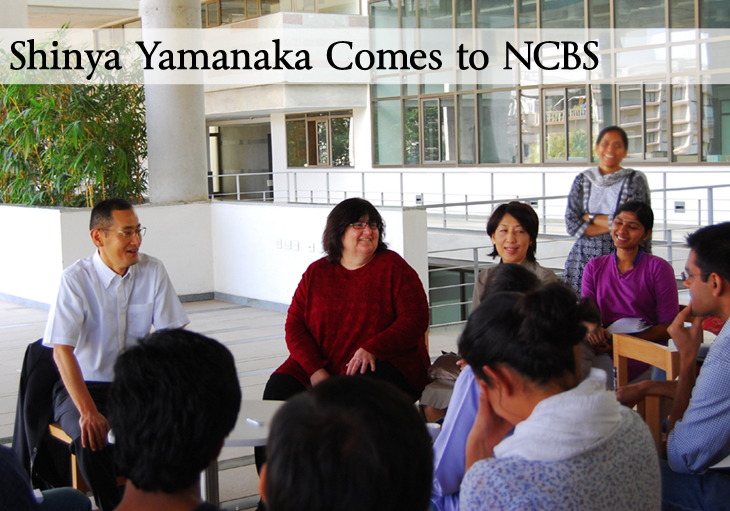Shinya Yamanaka comes to NCBS

Shinya Yamanaka interacting with students at NCBS. Photograph by Anupratap Tomar. Design by Aathira Perinchery.
Shinya Yamanaka, the doyen of stem cell biology, was at NCBS on 30th January 2012. In Bangalore to deliver a talk at the Indian Institute of Science as part of the Cell Press-TNQ India Distinguised Lectureship series, he took time out from his hectic schedule to interact with students from NCBS and inStem.
Yamanaka was listed as one of the '15 Asian Scientists To Watch' by the magazine Asian Scientist in 2011. Indeed, along with Martin Evans, Matthew Kaufman and Jamie Thomson, Yamanaka is one of the few stem cell biologists whose impact has been felt by all the field.
He set up his lab in 1999 at Nara Institute of Science and Technology, Nara, Japan with one goal: to determine if it is possible to reprogram a somatic cell (i.e. all cells in the human body that do not play a part in sexual reproduction) to a pluripotent cell (a cell whose fate is not yet locked in place, and that can thus form any part of the body). Yamanaka's first breakthrough came in 2003 when his group discovered a gene that was a major player in the pluripotency network of mice embryonic stem cells. What was interesting is that Ian Chambers' group in Edinburgh, using a different approach, had also discovered the same gene by that time. Like Darwin and Wallace, who published their famous papers on evolution back-to-back, the Yamanaka and Chambers labs shared their data and published one paper each in the same volume of Cell. They named the unknown gene Nanog after the mythological Celtic land of the ever-young, "Tir nan Og".
In 2006 Yamanaka's group published the landmark paper 'Induction of Pluripotent Stem Cells from Mouse Embryonic and Adult Fibroblast Cultures by Defined Factors', where they showed that it was possible to reprogram mouse somatic cells in-vitro using a combination of four genes to a pluripotent state. They quickly followed this discovery with their second breakthrough in 2007 in which they showed it was possible to reprogram human somatic cells using the same four genes. This paper paved the way for a possible bypass to the ethical challenges that are associated with using human embryonic stem cells. For his discovery in reprogramming he was awarded the Lasker Award, the next highest award after the Nobel prize in scientific circles, in 2009.
Yamanaka spent nearly an hour interacting with students at NCBS. In an informal setting he answered a wide range of questions thrown at him by students. He regaled the audience with his hilarious anecdotes and quick wit: when a student admitted that he was less intimidating once he had removed his coat, Yamanaka offered to take off his shirt too. A true gem of a person.
Comments
Post new comment